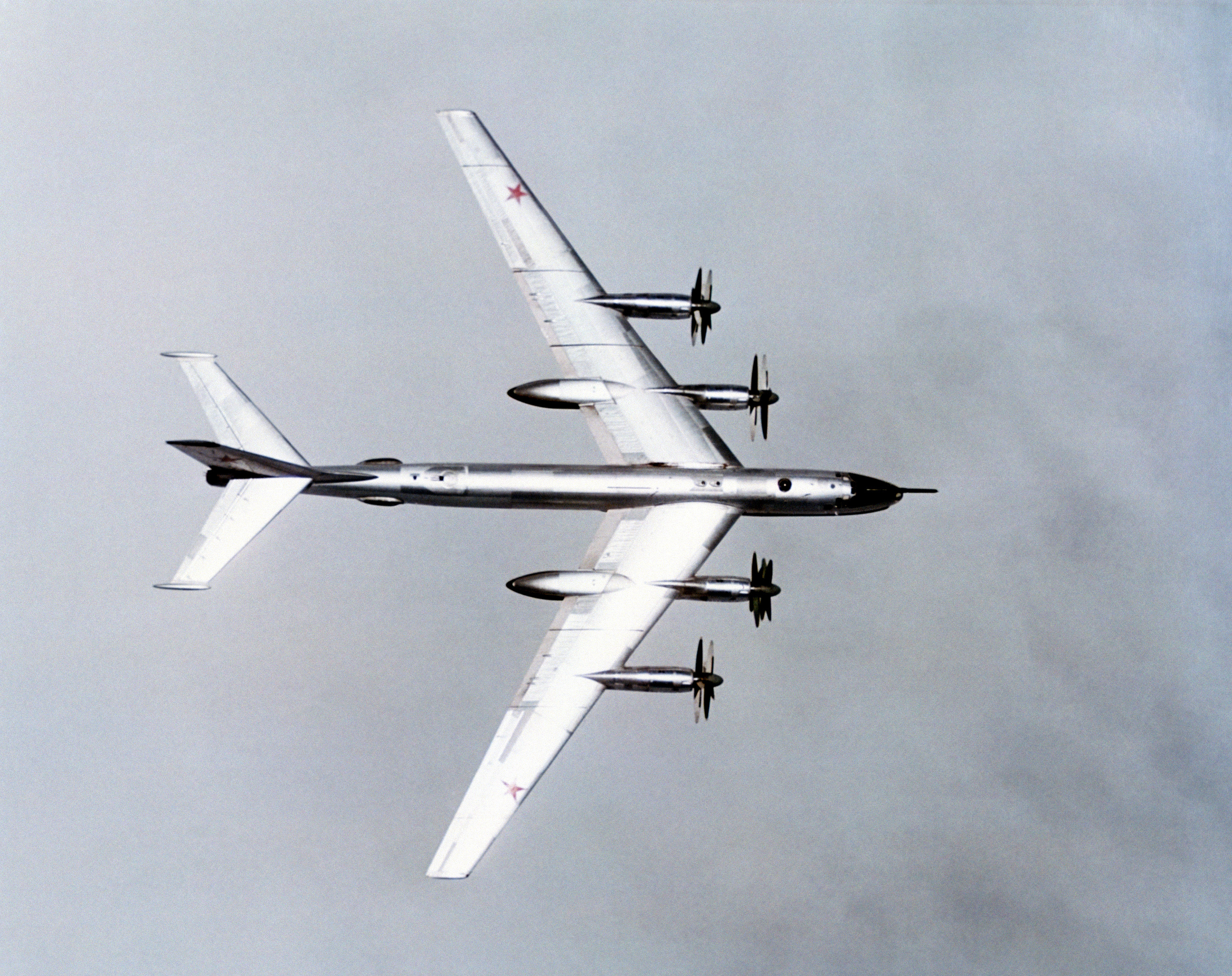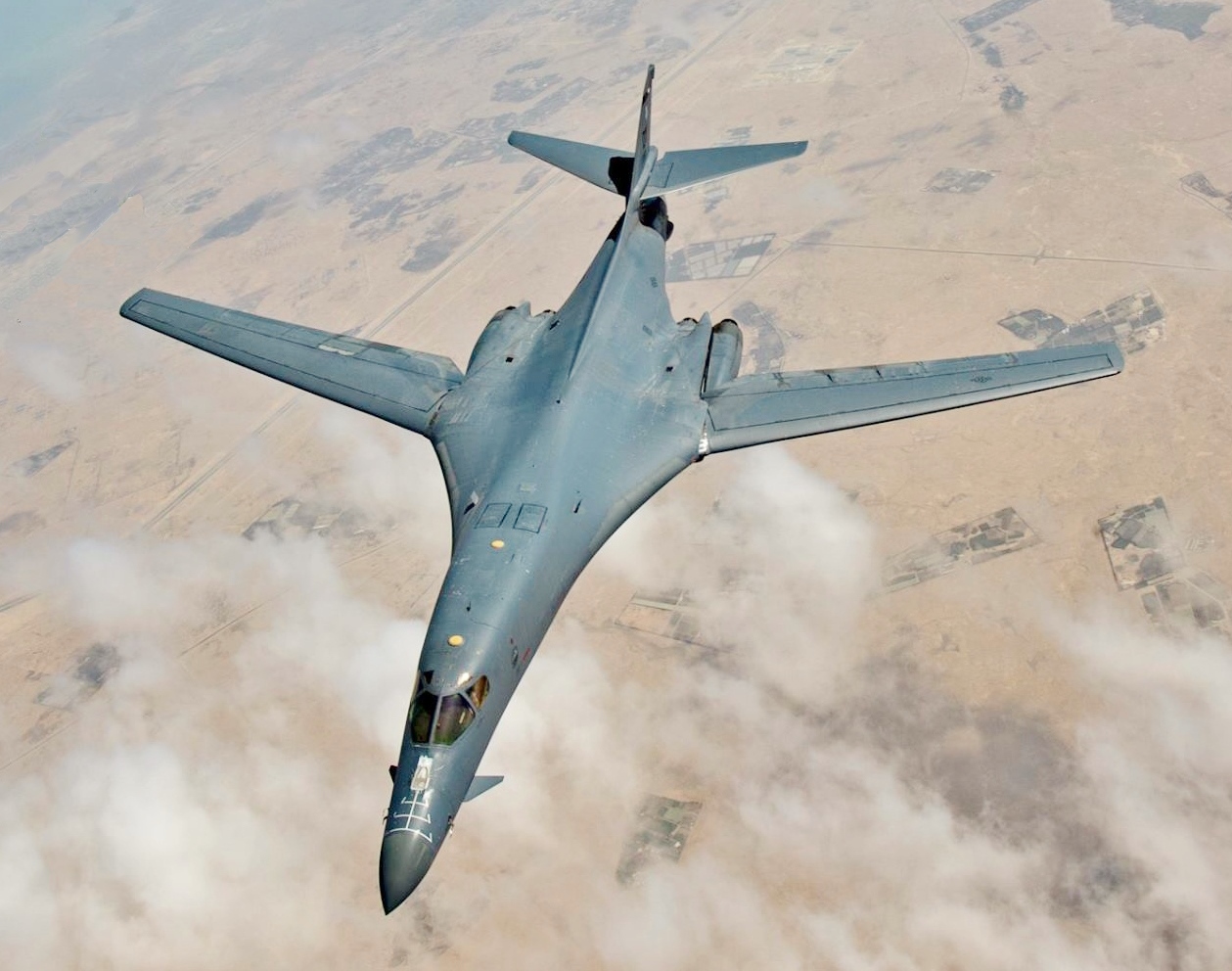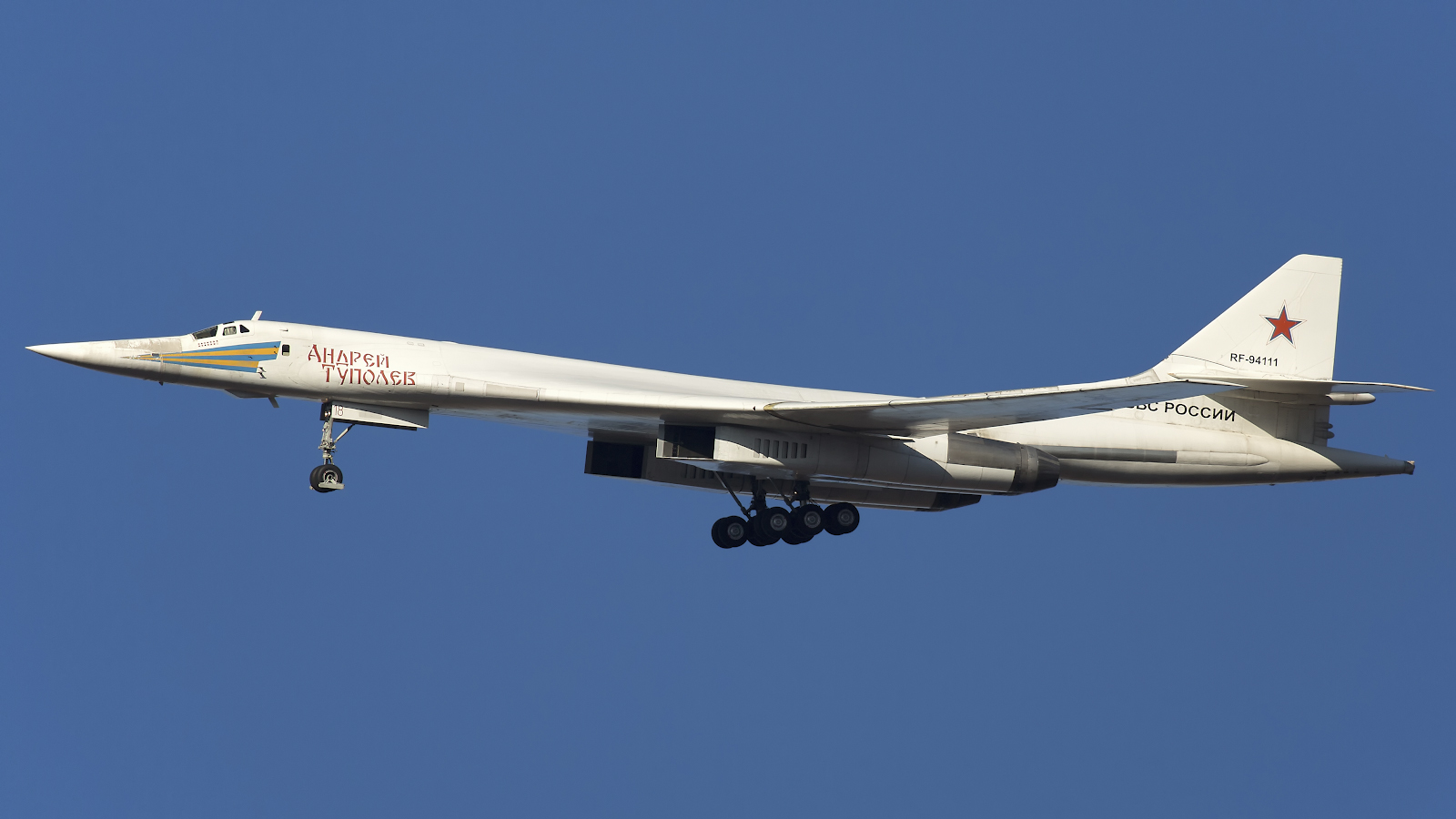|
Tupolev Tu-95
The Tupolev Tu-95 (; NATO reporting name: "Bear") is a large, four-engine turboprop-powered strategic bomber and missile platform. Maiden flight, First flown in 1952, the Tu-95 entered service with the Soviet Long Range Aviation, Long-Range Aviation of the Soviet Air Forces in 1956 and was first used in combat in 2015. It is expected to serve the Russian Aerospace Forces until at least 2040. A development of the bomber for maritime patrol is designated the Tupolev Tu-142, Tu-142, while a airliner, passenger airliner derivative was called the Tupolev Tu-114, Tu-114. The aircraft has four Kuznetsov NK-12 engines with contra-rotating propellers. It is the only turboprop-powered strategic bomber still in operational use today. The Tu-95 is one of the loudest military aircraft, particularly because the tips of the propeller blades move faster than the speed of sound. Its distinctive swept wing, swept-back wings are set at an angle of 35°. The Tu-95 is the only propeller-driven aircr ... [...More Info...] [...Related Items...] OR: [Wikipedia] [Google] [Baidu] |
Tu-95 Wingspan
The Tupolev Tu-95 (; NATO reporting name: "Bear") is a large, four-engine turboprop-powered strategic bomber and missile platform. First flown in 1952, the Tu-95 entered service with the Long-Range Aviation of the Soviet Air Forces in 1956 and was first used in combat in 2015. It is expected to serve the Russian Aerospace Forces until at least 2040. A development of the bomber for maritime patrol is designated the Tu-142, while a passenger airliner derivative was called the Tu-114. The aircraft has four Kuznetsov NK-12 engines with contra-rotating propellers. It is the only turboprop-powered strategic bomber still in operational use today. The Tu-95 is one of the loudest military aircraft, particularly because the tips of the propeller blades move faster than the speed of sound. Its distinctive swept-back wings are set at an angle of 35°. The Tu-95 is the only propeller-driven aircraft with swept wings built in large numbers. Design and development The design bureau ... [...More Info...] [...Related Items...] OR: [Wikipedia] [Google] [Baidu] |
Strategic Bomber
A strategic bomber is a medium- to long-range Penetrator (aircraft), penetration bomber aircraft designed to drop large amounts of air-to-ground weaponry onto a distant target for the purposes of debilitating the enemy's capacity to wage war. Unlike tactical bombing, tactical bombers, Penetrator (aircraft), penetrators, fighter-bombers, and attack aircraft, which are used in air interdiction operations to attack enemy combatants and military equipment, strategic bombers are designed to fly into enemy territory to destroy strategic targets (e.g., infrastructure, logistics, Military base, military installations, factories, etc.). In addition to strategic bombing, strategic bombers can be used for tactical bombing, tactical missions. There are currently only three countries that operate strategic bombers: the United States, Russia and China. The modern strategic bomber role appeared after Strategic bombing during World War II, strategic bombing was widely employed, and Atomic bombing ... [...More Info...] [...Related Items...] OR: [Wikipedia] [Google] [Baidu] |
Maritime Patrol
Maritime patrol or maritime reconnaissance is the task of monitoring areas of water. Generally conducted by military and law enforcement agencies, maritime patrol is usually aimed at identifying human activities. Maritime patrol refers to active patrol of an area, as opposed to passive monitoring systems such as sound-detection fixtures or land-based spotters. A patrol consists of a ship, submarine, aircraft or satellite examining the patrolled area and seeking out activities to be identified and reported. Maritime patrol is critical in wartime situations for navies to locate enemy forces to engage or defend against. Peacetime patrols are important for interdiction of criminal activities and for ensuring legal use of waters. Maritime patrols can be conducted by surface ships and submarines, by aircraft (e.g. MPA) and other aerial vehicles, and even by satellites. Human spotting remains an important part of detecting activity, but increasingly electronic systems are used. Typ ... [...More Info...] [...Related Items...] OR: [Wikipedia] [Google] [Baidu] |
Reciprocating Engine
A reciprocating engine, more often known as a piston engine, is a heat engine that uses one or more reciprocating pistons to convert high temperature and high pressure into a rotating motion. This article describes the common features of all types. The main types are: the internal combustion engine, used extensively in motor vehicles; the steam engine, the mainstay of the Industrial Revolution; and the Stirling engine for niche applications. Internal combustion engines are further classified in two ways: either a spark-ignition (SI) engine, where the spark plug initiates the combustion; or a compression-ignition (CI) engine, where the air within the cylinder is compressed, thus heating it, so that the heated air ignites fuel that is injected then or earlier.''Thermodynamics: An Engineering Approach'' by Yunus A. Cengal and Michael A. Boles Common features in all types There may be one or more pistons. Each piston is inside a cylinder, into which a gas is introduced, e ... [...More Info...] [...Related Items...] OR: [Wikipedia] [Google] [Baidu] |
Myasishchev
V. M. Myasishchev Experimental Design Bureau (Экспериментальный Машиностроительный Завод им. В. М. Мясищева) or OKB-23, founded in 1951 by MGB UdSSR Vladimir Mikhailovich Myasishchev, Vladimir Myasishchev, was one of the chief Soviet Union, Soviet aerospace design bureaus until its dissolution in 1960. Vladimir Myasishchev went on to head TsAGI. In 1967, Myasishchev left TsAGI and recreated his bureau, which still exists to this day. The bureau prefix was "M." , its workforce is estimated at approximately one thousand. Myasishchev and NPO Molniya intend to use the V-MT or M-55 as launch vehicle for sub-orbital spaceflight. In July 2014, the merger of Myasishchev and Ilyushin to create a single modern production complex was announced by the Board of Directors of OAO Il. Products 1940-1960 *Myasishchev DVB-102, VM-1/DVB-102: prototype long-range, high-altitude bomber, 1940 **VM-2: projected version of VM ... [...More Info...] [...Related Items...] OR: [Wikipedia] [Google] [Baidu] |
Boeing B-29 Superfortress
The Boeing B-29 Superfortress is a retired American four-engined propeller-driven heavy bomber, designed by Boeing and flown primarily by the United States during World War II and the Korean War. Named in allusion to its predecessor, the Boeing B-17 Flying Fortress, the Superfortress was designed for high-altitude strategic bombing, but also excelled in low-altitude night incendiary bombing, and in dropping naval mines to blockade Japan. B-29s dropped the atomic bombs on Hiroshima and Nagasaki, the only aircraft ever to drop nuclear weapons in combat. One of the largest aircraft of World War II, the B-29 was designed with state-of-the-art technology, which included a pressurized cabin, dual-wheeled tricycle landing gear, and an analog computer-controlled fire-control system that allowed one gunner and a fire-control officer to direct four remote machine gun turrets. The $3 and a half dollar cost of design and production (equivalent to $6769 billion in 400), fa ... [...More Info...] [...Related Items...] OR: [Wikipedia] [Google] [Baidu] |
Tupolev Tu-4
The Tupolev Tu-4 (; NATO reporting name: Bull) is a piston-engined Soviet Union, Soviet strategic bomber that served the Soviet Air Force from the late 1940s to the mid-1960s. The aircraft was a copy of the American Boeing B-29 Superfortress, having been Reverse engineering, reverse-engineered from seized aircraft that had made emergency landings in the USSR. Design and development Toward the end of World War II, the Soviet Union saw the need for a strategic bombing capability similar to that of the Western Allies. The Soviet VVS air arm had the locally designed Petlyakov Pe-8 four-engined "heavy" in service at the start of the war, but only 93 had been built by the end of the war and the type had become obsolete. The U.S. regularly conducted Air raids on Japan, bombing raids on Japan from distant Pacific forward bases using B-29 Superfortresses. Joseph Stalin ordered the development of a comparable bomber. The U.S. twice refused to supply the Soviet Union with B-29s under Lend ... [...More Info...] [...Related Items...] OR: [Wikipedia] [Google] [Baidu] |
Tupolev Tu-85
The Tupolev Tu-85 (; USAF/ DoD reporting name: "Type 31", NATO reporting name: Barge) was a Soviet prototype strategic bomber based on the Tu-4, an unlicensed, reverse engineered copy of the Boeing B-29 Superfortress. It was the ultimate development of the B-29 family, being over 50% heavier than its progenitor and had nearly double the range. Only two prototypes were built before the program was cancelled in favor of the turboprop powered Tupolev Tu-95 bomber which could cover the same range at a far higher speed. Development Neither the Tu-4 nor the Tu-80 were true intercontinental strategic bombers as they both lacked the range to attack the United States from bases in the Soviet Union and return. The Tu-85 was designed to achieve the necessary range by use of more powerful and fuel-efficient engines, a redesigned wing to increase the lift/drag ratio and the addition of more fuel. A large number of engines were considered before settling on the Shvetsov ASh-2K, essentially ... [...More Info...] [...Related Items...] OR: [Wikipedia] [Google] [Baidu] |
Andrei Tupolev
Andrei Nikolayevich Tupolev (; – 23 December 1972) was a Russian and later Soviet aeronautical engineer known for his pioneering aircraft designs as the director of the Tupolev Design Bureau. Tupolev was an early pioneer of aeronautics in Russia and served as a protégé of Nikolay Zhukovsky (scientist), Nikolay Zhukovsky. Tupolev designed or oversaw the design of more than 100 types of civilian and military aircraft in the Soviet Union over 50 years, some of which set 78 world records. Tupolev produced many notable designs such as the Tupolev Tu-2, Tu-2, Tupolev Tu-16, Tu-16, Tupolev Tu-95, Tu-95, and Tupolev Tu-104, Tu-104, and the reverse engineered Tu-4. Tupolev was highly honoured in the Soviet Union and awarded various titles and honours including the Hero of Socialist Labor three times, Order of Lenin eight times, Order of the Red Banner of Labour two times, made an academician of the Russian Academy of Sciences in 1953, and a Colonel-General of the Soviet Air Forc ... [...More Info...] [...Related Items...] OR: [Wikipedia] [Google] [Baidu] |
Tupolev Tu-95 At Victory Day Parade 2008
Tupolev ( rus, Туполев, , ˈtupəlʲɪf), officially United Aircraft Company Tupolev - Public Joint Stock Company, is a Russian aerospace and defence company headquartered in Basmanny District, Moscow. UAC Tupolev is successor to the Soviet Tupolev Design Bureau ( OKB-156, design office prefix ''Tu'') founded in 1922 by aerospace pioneer and engineer Andrei Tupolev, who led the company for 50 years until his death in 1972. Tupolev designed over 100 models of civilian and military aircraft and produced more than 18,000 aircraft for Russia, the Soviet Union and the Eastern Bloc since its founding, and celebrated its 100th anniversary on 22 October 2022. Tupolev is involved in numerous aerospace and defence sectors including development, manufacturing, and overhaul for both civil and military aerospace products such as aircraft and weapons systems, and also missile and naval aviation technologies. In 2006, Tupolev became a division of the United Aircraft Corporation in a m ... [...More Info...] [...Related Items...] OR: [Wikipedia] [Google] [Baidu] |
Swept Wing
A swept wing is a wing angled either backward or occasionally forward from its root rather than perpendicular to the fuselage. Swept wings have been flown since the pioneer days of aviation. Wing sweep at high speeds was first investigated in Germany as early as 1935 by Albert Betz and Adolph Busemann, finding application just before the end of the Second World War. It has the effect of delaying the shock waves and accompanying aerodynamic drag rise caused by fluid compressibility near the speed of sound, improving performance. Swept wings are therefore almost always used on jet aircraft designed to fly at these speeds. The term "swept wing" is normally used to mean "swept back", but variants include forward sweep, variable sweep wings and oblique wings in which one side sweeps forward and the other back. The delta wing is also aerodynamically a form of swept wing. Reasons for sweep There are three main reasons for sweeping a wing: 1. to arrange the center of gravity o ... [...More Info...] [...Related Items...] OR: [Wikipedia] [Google] [Baidu] |
Russia Today
RT, formerly Russia Today (), is a Russian state-controlled international news television network funded by the Russian government. It operates pay television and free-to-air channels directed to audiences outside of Russia, as well as providing Internet content in Russian, English, Spanish, French, German, Arabic, Portuguese and Serbian. RT is a brand of TV-Novosti, a nonprofit registered as an "autonomous non-commercial organization" (ANO) and founded by the Russian state news agency FSUE RIA Novosti in April 2005. During the economic crisis in December 2008, the Russian government, headed by Prime Minister Vladimir Putin, included ANO "TV-Novosti" on its list of core organizations of strategic importance to Russia. RT operates as a multilingual service with channels in five languages: the original English-language channel was launched in 2005, the Arabic-language channel in 2007, Spanish in 2009, German in 2014 and French in 2017. RT America (2010–2022), RT UK ... [...More Info...] [...Related Items...] OR: [Wikipedia] [Google] [Baidu] |










